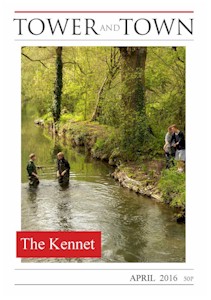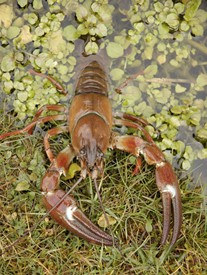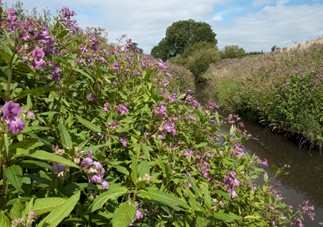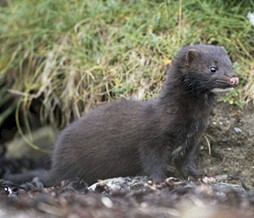Tower and Town, April 2016 (view the full edition) (view the full edition)
Kennet FaunaHester Bromovsky explores the native fauna of the river Kennet and investigates the invasive species that are threatening them. The River Kennetís mineral rich water hosts a wide range of precious flora and fauna. Some of these species are under threat.
Research has stated that the crayfish native to the River Kennet will be extinct in two decades unless something is done to protect them.  They are under threat from the invasive North American Signal Crayfish. The native crayfish can be identified by their white claws and are smaller than the invasive species which threatens them. The White-Clawed Crayfish are very common in parts of the river, lurking by day in holes and roots on the bank, but emerging at dusk to feed. Signal Crayfish are aggressive and fast breeding. On average they are c.5cm long. They have put the native white clawed crayfish in danger because they compete for the same types of food but the Signal Crayfish are faster and therefore leave no food for the native crayfish. Not only this but they also carry a water borne fungus which is fatal to the native species. They are under threat from the invasive North American Signal Crayfish. The native crayfish can be identified by their white claws and are smaller than the invasive species which threatens them. The White-Clawed Crayfish are very common in parts of the river, lurking by day in holes and roots on the bank, but emerging at dusk to feed. Signal Crayfish are aggressive and fast breeding. On average they are c.5cm long. They have put the native white clawed crayfish in danger because they compete for the same types of food but the Signal Crayfish are faster and therefore leave no food for the native crayfish. Not only this but they also carry a water borne fungus which is fatal to the native species.
Another invasive species is the Himalayan Balsam.  This is a densely growing pink- and red-stemmed weed. It was introduced in Britain in 1839, when the plant escaped from gardens and rapidly colonised river banks and other areas of damp land. It is the tallest annual plant in Britain as it grows up to three metres. Not only is it very tall but it is incredibly dense, so that it stifles the other, native grasses and blocks the light from them causing them to die. The plant blooms in June but by autumn it dies back leaving the banks bare and liable to erosion. The Himalayan Balsam threatens plants such as grey willow and rare copper moss, which grow on the banks of the Kennet. This is a densely growing pink- and red-stemmed weed. It was introduced in Britain in 1839, when the plant escaped from gardens and rapidly colonised river banks and other areas of damp land. It is the tallest annual plant in Britain as it grows up to three metres. Not only is it very tall but it is incredibly dense, so that it stifles the other, native grasses and blocks the light from them causing them to die. The plant blooms in June but by autumn it dies back leaving the banks bare and liable to erosion. The Himalayan Balsam threatens plants such as grey willow and rare copper moss, which grow on the banks of the Kennet.
The American Mink has come to Britain from North America. It first arrived in 1929, when it was fashionable to wear mink fur. People created farms all around Britain. By the 1950ís huge numbers of mink had escaped, and there were also a few deliberate releases so that it is now impossible to estimate the number of mink in Britain today. They usually hunt in woodland and near water courses where they eat fish.  They have endangered many native species but in particular the water vole. The water vole is often mistaken for a rat but it has a much rounder head and browner fur. Their burrow entrances are often just above waters edge. These are found on the banks of the Kennet around Marlborough. They have endangered many native species but in particular the water vole. The water vole is often mistaken for a rat but it has a much rounder head and browner fur. Their burrow entrances are often just above waters edge. These are found on the banks of the Kennet around Marlborough.
The Kennet provides a rare and special environment for many of our native species. Preserving and conserving them is of huge importance to us all. Hester Bromovsky | 

 (view the full edition)
(view the full edition)